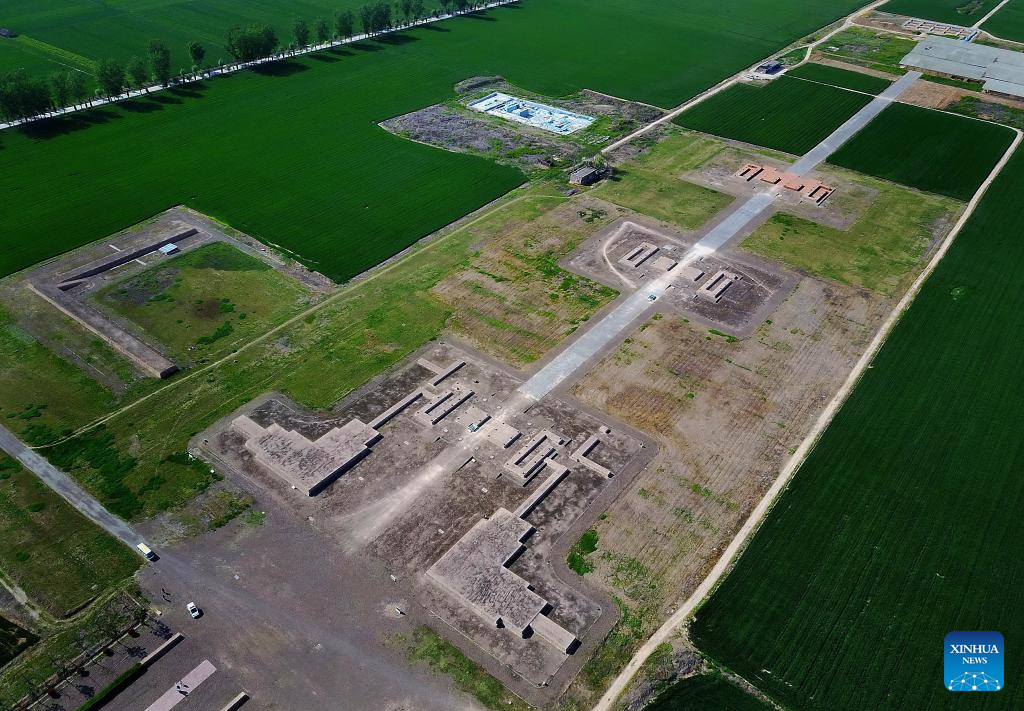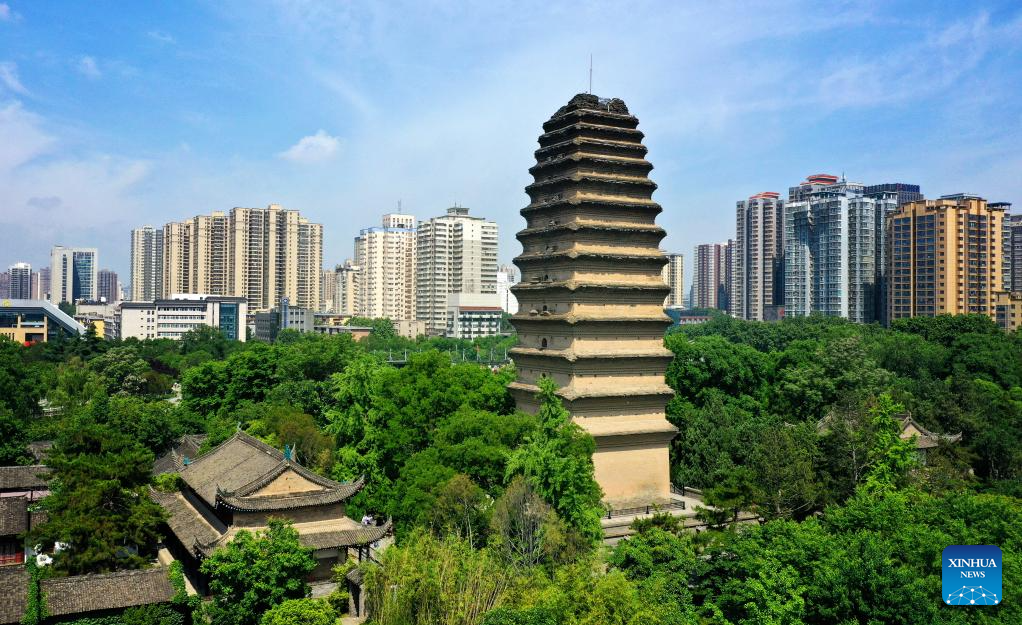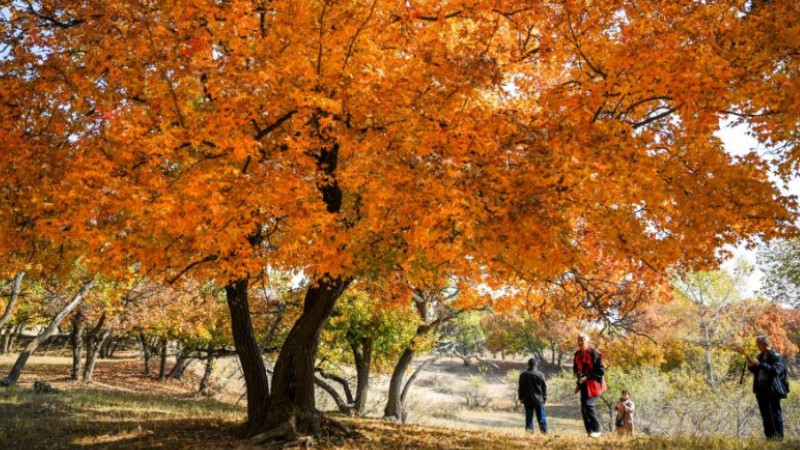Silk Roads: Routes Network of Chang'an-Tianshan Corridor

This aerial photo taken on April 21, 2017 shows the ruins of an old palace of the ancient city of Han (202 B.C.- A.D. 220) and Wei (220-265) dynasties in Luoyang, central China's Henan Province. About 2,000 years ago, in the Western Han Dynasty (202 B.C.- A.D. 25), a Chinese envoy named Zhang Qian began his expedition to the Western Regions and opened a trade route that later became the Silk Road.
In 2014, a joint application by China, Kazakhstan, and Kyrgyzstan led to the recognition of "the Silk Roads: the Routes Network of Chang'an-Tianshan Corridor" as a UNESCO World Heritage Site.
Spanning thousands of miles and thousands of years, the ancient Silk Road was not only a route for trade and barter, but also a route for exchanges between civilizations, making a significant contribution to the development and progress of human society. (Xinhua/Li An)

This aerial photo taken on May 8, 2023 shows a view of the Small Wild Goose Pagoda in Xi'an, northwest China's Shaanxi Province. About 2,000 years ago, in the Western Han Dynasty (202 B.C.- A.D. 25), a Chinese envoy named Zhang Qian began his expedition to the Western Regions and opened a trade route that later became the Silk Road.
In 2014, a joint application by China, Kazakhstan, and Kyrgyzstan led to the recognition of "the Silk Roads: the Routes Network of Chang'an-Tianshan Corridor" as a UNESCO World Heritage Site.
Spanning thousands of miles and thousands of years, the ancient Silk Road was not only a route for trade and barter, but also a route for exchanges between civilizations, making a significant contribution to the development and progress of human society. (Xinhua/Liu Xiao)

This aerial photo taken on April 19, 2023 shows a view of the Giant Wild Goose Pagoda in Xi'an, northwest China's Shaanxi Province. About 2,000 years ago, in the Western Han Dynasty (202 B.C.- A.D. 25), a Chinese envoy named Zhang Qian began his expedition to the Western Regions and opened a trade route that later became the Silk Road.
In 2014, a joint application by China, Kazakhstan, and Kyrgyzstan led to the recognition of "the Silk Roads: the Routes Network of Chang'an-Tianshan Corridor" as a UNESCO World Heritage Site.
Spanning thousands of miles and thousands of years, the ancient Silk Road was not only a route for trade and barter, but also a route for exchanges between civilizations, making a significant contribution to the development and progress of human society. (Xinhua/Liu Xiao)

This aerial photo taken on May 31, 2023 shows the Maijishan Grottoes in Tianshui City, northwest China's Gansu Province. About 2,000 years ago, in the Western Han Dynasty (202 B.C.- A.D. 25), a Chinese envoy named Zhang Qian began his expedition to the Western Regions and opened a trade route that later became the Silk Road.
In 2014, a joint application by China, Kazakhstan, and Kyrgyzstan led to the recognition of "the Silk Roads: the Routes Network of Chang'an-Tianshan Corridor" as a UNESCO World Heritage Site.
Spanning thousands of miles and thousands of years, the ancient Silk Road was not only a route for trade and barter, but also a route for exchanges between civilizations, making a significant contribution to the development and progress of human society. (Xinhua/Lang Bingbing)

This aerial photo taken on April 29, 2022 shows the Maijishan Grottoes in Tianshui City, northwest China's Gansu Province. About 2,000 years ago, in the Western Han Dynasty (202 B.C.- A.D. 25), a Chinese envoy named Zhang Qian began his expedition to the Western Regions and opened a trade route that later became the Silk Road.
In 2014, a joint application by China, Kazakhstan, and Kyrgyzstan led to the recognition of "the Silk Roads: the Routes Network of Chang'an-Tianshan Corridor" as a UNESCO World Heritage Site.
Spanning thousands of miles and thousands of years, the ancient Silk Road was not only a route for trade and barter, but also a route for exchanges between civilizations, making a significant contribution to the development and progress of human society. (Xinhua/Chen Bin)

This aerial photo taken on Jan. 14, 2023 shows the ruins of an old palace of the ancient city of Han (202 B.C.- A.D. 220) and Wei (220-265) dynasties in Luoyang, central China's Henan Province. About 2,000 years ago, in the Western Han Dynasty (202 B.C.- A.D. 25), a Chinese envoy named Zhang Qian began his expedition to the Western Regions and opened a trade route that later became the Silk Road.
In 2014, a joint application by China, Kazakhstan, and Kyrgyzstan led to the recognition of "the Silk Roads: the Routes Network of Chang'an-Tianshan Corridor" as a UNESCO World Heritage Site.
Spanning thousands of miles and thousands of years, the ancient Silk Road was not only a route for trade and barter, but also a route for exchanges between civilizations, making a significant contribution to the development and progress of human society. (Xinhua/Li An)

This aerial photo taken on April 25, 2023 shows a view of the Xi'an Railway Station and the Daming Palace National Heritage Park behind it in Xi'an, northwest China's Shaanxi Province. About 2,000 years ago, in the Western Han Dynasty (202 B.C.- A.D. 25), a Chinese envoy named Zhang Qian began his expedition to the Western Regions and opened a trade route that later became the Silk Road.
In 2014, a joint application by China, Kazakhstan, and Kyrgyzstan led to the recognition of "the Silk Roads: the Routes Network of Chang'an-Tianshan Corridor" as a UNESCO World Heritage Site.
Spanning thousands of miles and thousands of years, the ancient Silk Road was not only a route for trade and barter, but also a route for exchanges between civilizations, making a significant contribution to the development and progress of human society. (Xinhua/Shao Rui)

This aerial photo taken on Sept. 30, 2023 shows parade floats past the Daming Palace National Heritage Park in Xi'an, northwest China's Shaanxi Province. About 2,000 years ago, in the Western Han Dynasty (202 B.C.- A.D. 25), a Chinese envoy named Zhang Qian began his expedition to the Western Regions and opened a trade route that later became the Silk Road.
In 2014, a joint application by China, Kazakhstan, and Kyrgyzstan led to the recognition of "the Silk Roads: the Routes Network of Chang'an-Tianshan Corridor" as a UNESCO World Heritage Site.
Spanning thousands of miles and thousands of years, the ancient Silk Road was not only a route for trade and barter, but also a route for exchanges between civilizations, making a significant contribution to the development and progress of human society. (Xinhua/Liu Xiao)

This aerial photo taken on Sept. 8, 2023 shows the Kizilgaha Beacon Tower in Kuqa City, northwest China's Xinjiang Uygur Autonomous Region. About 2,000 years ago, in the Western Han Dynasty (202 B.C.- A.D. 25), a Chinese envoy named Zhang Qian began his expedition to the Western Regions and opened a trade route that later became the Silk Road.
In 2014, a joint application by China, Kazakhstan, and Kyrgyzstan led to the recognition of "the Silk Roads: the Routes Network of Chang'an-Tianshan Corridor" as a UNESCO World Heritage Site.
Spanning thousands of miles and thousands of years, the ancient Silk Road was not only a route for trade and barter, but also a route for exchanges between civilizations, making a significant contribution to the development and progress of human society. (Xinhua/Ding Lei)

This aerial photo taken on Aug. 11, 2023 shows Jiaohe ancient city in Turpan, northwest China's Xinjiang Uygur Autonomous Region. About 2,000 years ago, in the Western Han Dynasty (202 B.C.- A.D. 25), a Chinese envoy named Zhang Qian began his expedition to the Western Regions and opened a trade route that later became the Silk Road.
In 2014, a joint application by China, Kazakhstan, and Kyrgyzstan led to the recognition of "the Silk Roads: the Routes Network of Chang'an-Tianshan Corridor" as a UNESCO World Heritage Site.
Spanning thousands of miles and thousands of years, the ancient Silk Road was not only a route for trade and barter, but also a route for exchanges between civilizations, making a significant contribution to the development and progress of human society. (Xinhua/Ma Ning)

This aerial photo taken on Sept. 13, 2023 shows the site of Talgar in Kazakhstan. About 2,000 years ago, in the Western Han Dynasty (202 B.C.- A.D. 25), a Chinese envoy named Zhang Qian began his expedition to the Western Regions and opened a trade route that later became the Silk Road.
In 2014, a joint application by China, Kazakhstan, and Kyrgyzstan led to the recognition of "the Silk Roads: the Routes Network of Chang'an-Tianshan Corridor" as a UNESCO World Heritage Site.
Spanning thousands of miles and thousands of years, the ancient Silk Road was not only a route for trade and barter, but also a route for exchanges between civilizations, making a significant contribution to the development and progress of human society. (Photo by Alisher Bayazitov/Xinhua)

This aerial photo taken on Oct. 6, 2023 shows the City of Suyab in Kyrgyzstan. About 2,000 years ago, in the Western Han Dynasty (202 B.C.- A.D. 25), a Chinese envoy named Zhang Qian began his expedition to the Western Regions and opened a trade route that later became the Silk Road.
In 2014, a joint application by China, Kazakhstan, and Kyrgyzstan led to the recognition of "the Silk Roads: the Routes Network of Chang'an-Tianshan Corridor" as a UNESCO World Heritage Site.
Spanning thousands of miles and thousands of years, the ancient Silk Road was not only a route for trade and barter, but also a route for exchanges between civilizations, making a significant contribution to the development and progress of human society. (Photo by Anarbek Imankozhoev/Xinhua)

This aerial photo taken on Sept. 12, 2023 shows the site of Talgar in Kazakhstan. About 2,000 years ago, in the Western Han Dynasty (202 B.C.- A.D. 25), a Chinese envoy named Zhang Qian began his expedition to the Western Regions and opened a trade route that later became the Silk Road.
In 2014, a joint application by China, Kazakhstan, and Kyrgyzstan led to the recognition of "the Silk Roads: the Routes Network of Chang'an-Tianshan Corridor" as a UNESCO World Heritage Site.
Spanning thousands of miles and thousands of years, the ancient Silk Road was not only a route for trade and barter, but also a route for exchanges between civilizations, making a significant contribution to the development and progress of human society. (Photo by Alisher Bayazitov/Xinhua)

This aerial photo taken on Oct. 15, 2023 shows the site of Yumen Pass in Dunhuang, northwest China's Gansu Province. About 2,000 years ago, in the Western Han Dynasty (202 B.C.- A.D. 25), a Chinese envoy named Zhang Qian began his expedition to the Western Regions and opened a trade route that later became the Silk Road.
In 2014, a joint application by China, Kazakhstan, and Kyrgyzstan led to the recognition of "the Silk Roads: the Routes Network of Chang'an-Tianshan Corridor" as a UNESCO World Heritage Site.
Spanning thousands of miles and thousands of years, the ancient Silk Road was not only a route for trade and barter, but also a route for exchanges between civilizations, making a significant contribution to the development and progress of human society. (Xinhua/Zhang Zhimin)

This aerial photo taken on Oct. 15, 2023 shows the site of Yumen Pass in Dunhuang, northwest China's Gansu Province. About 2,000 years ago, in the Western Han Dynasty (202 B.C.- A.D. 25), a Chinese envoy named Zhang Qian began his expedition to the Western Regions and opened a trade route that later became the Silk Road.
In 2014, a joint application by China, Kazakhstan, and Kyrgyzstan led to the recognition of "the Silk Roads: the Routes Network of Chang'an-Tianshan Corridor" as a UNESCO World Heritage Site.
Spanning thousands of miles and thousands of years, the ancient Silk Road was not only a route for trade and barter, but also a route for exchanges between civilizations, making a significant contribution to the development and progress of human society. (Xinhua/Zhang Zhimin)

This aerial photo taken on Oct. 6, 2023 shows the City of Suyab in Kyrgyzstan. About 2,000 years ago, in the Western Han Dynasty (202 B.C.- A.D. 25), a Chinese envoy named Zhang Qian began his expedition to the Western Regions and opened a trade route that later became the Silk Road.
In 2014, a joint application by China, Kazakhstan, and Kyrgyzstan led to the recognition of "the Silk Roads: the Routes Network of Chang'an-Tianshan Corridor" as a UNESCO World Heritage Site.
Spanning thousands of miles and thousands of years, the ancient Silk Road was not only a route for trade and barter, but also a route for exchanges between civilizations, making a significant contribution to the development and progress of human society. (Photo by Anarbek Imankozhoev/Xinhua)
Photos
Related Stories
- BRI In Numbers: Cultivating Global Connectivity
- China, Ethiopia announce elevating bilateral ties to all-weather strategic partnership
- Why has China achieved remarkable successes in promoting cooperation under Belt and Road Initiative?
- BRI cooperation ushers in heartening stories of the times
- Mombasa-Nairobi SGR: a flagship project of BRI
- A decade of BRI: From vision to reality
- Interview: Cambodia "exemplar" of Belt and Road success story, says expert
- Interview: BRI's 10th anniversary worthy of celebration: Hungarian expert
- Conference participants to ink host of agreements
- Feature: High hopes for Cambodia's touristic, economic growth as Chinese-invested airport starts operation
Copyright © 2023 People's Daily Online. All Rights Reserved.









